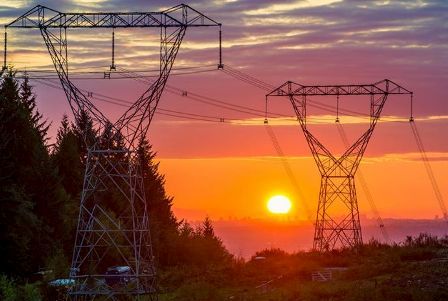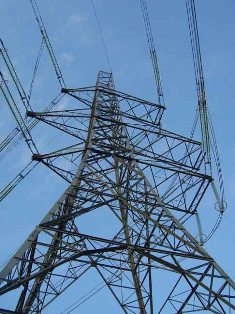Supports of overhead power lines, materials and types of supports
General characteristics of overhead line supports
Overhead line supports support conductors at the required distance from the earth's surface, conductors of other lines, roofs of buildings, etc. The supports must be mechanically strong enough under different weather conditions (wind, ice, etc.).
Softwood, mainly pine and larch, followed by fir and spruce (for lines with a voltage of 35 kV and lower) is widely used as a support material for rural lines. Spruce and fir cannot be used for crossbars and fixing supports.
Wooden supports made of round wood - logs with the bark removed. The standard length of the logs varies from 5 to 13 m to 0.5 m, and the diameter in the upper section is from 12 to 26 cm in 2 cm. The thickness of the log at the butt, that is, at the lower, thick end, is determined by the natural taper of the trunk of the tree. The change in the diameter of the log for each linear meter of its length, called the run, is taken to be 0.8 cm.The longer the length of the logs for the supports (the longer the timber), the higher the price per cubic meter of timber.
The main disadvantage of wooden poles for power lines is the short service life due to decay of the wood, especially where it emerges from the ground to the surface. In this regard, the operating costs for the repair of the supports constitute about 16% of their cost.

The wood of the poles is exposed to external conditions and especially to fluctuating humidity at the place of installation in the ground. As a result, it rots, collapses and, if no special measures are taken, quickly fails.
Ways to antisepticize wood for wooden poles from overhead lines
The service life of untreated wooden supports is: for pine support 4-5 years, larch 14-15 years, spruce 3-4 years. In the southern regions, where high temperatures contribute to accelerated decay of wood, the service life of untreated supports is reduced by 1.5 — 2 times against the given figures. In this regard, it is necessary to use only logs impregnated with an antiseptic, with the exception of winter sawdust, which does not require impregnation.
Impregnating wood with oil antiseptics reduces the strength of the wood by up to 10%. The main value of impregnation with oil antiseptics depends not on the depth of impregnation, but on the quality of wood drying.
In addition, the oil antiseptic does not leach out. The wood must be impregnated after bringing it to a dry air state, that is, its humidity is equal to that of the air in a given area.
In this condition, the wood will not lose its moisture, shrinkage cracks will not appear, and fungal spores will have no place to develop.
When wet wood is impregnated, the latter will dry out, cracks will appear in it, and even deep impregnation will not help save the wood from rotting.
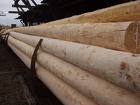
The best method of preserving wood is recognized to be impregnated with coal oil obtained by the distillation of crude coal tar. Impregnation with anthracene oil and reflux also gives good results. The moisture content of the wood should be no more than 25%.
Logs intended for the production of props are loaded into a steel cylinder during impregnation. A preservative liquid is introduced into it and a pressure of up to 0.9 MPa is created for some time so that the liquid can penetrate deep into the wood. A vacuum is then created in the cylinder so that the liquid is glass. This completes the impregnation process. The service life of the supports with the described method of impregnation increases significantly and reaches 25-30 years. In foreign practice, even 35-40 years is accepted.
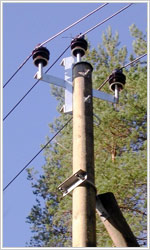 Pine and spruce wood can be impregnated with water-soluble antiseptics. Donalit of various brands is recommended for this purpose. When wood is impregnated in steel pressure bottles, the moisture content can range from 30 to 80%. The wood is loaded into the cylinder for 15 minutes, a vacuum is created in it, then an antiseptic solution is fed under a pressure of 1.3 MPa for 1 ... 2.5 hours.
Pine and spruce wood can be impregnated with water-soluble antiseptics. Donalit of various brands is recommended for this purpose. When wood is impregnated in steel pressure bottles, the moisture content can range from 30 to 80%. The wood is loaded into the cylinder for 15 minutes, a vacuum is created in it, then an antiseptic solution is fed under a pressure of 1.3 MPa for 1 ... 2.5 hours.
Wood with a moisture content of 60 — 80% can be impregnated with water-soluble antiseptics also in baths for 20 hours, followed by heating to 100 — 110 ° C for 2 hours.
Spruce, fir and larch wood must be scored to a depth of 15 mm before impregnation in any way. Stroke length 6 — 19 mm, width 3 mm. The pin mesh depends on the type of impregnation.
In order to increase the service life of pads impregnated with water-soluble antiseptics, it is recommended after 15-17 years of operation to put antiseptic bandages on them. The bandage is placed on a part of the support located 30 cm above the ground and 30 cm below it. It is made of a strip of tar, roofing material or pergalin with a width of 70 cm. A layer of antiseptic paste is applied to the pad, the bandage is nailed and tied with wire. The post near the bandage and the bandage itself are covered with a layer of bitumen.
Taking into account the poisonous and fire-hazardous properties of antiseptics, work on impregnating wood using the diffusion method is carried out in accordance with safety rules.
Reinforced concrete supports of overhead lines
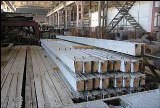 The advantages of reinforced concrete supports are practically unlimited service life and low operating costs.
The advantages of reinforced concrete supports are practically unlimited service life and low operating costs.
Reinforced concrete poles are superior to wooden and metal poles in terms of durability, while there are practically no operating costs, their production requires 65 - 70% less metal than metal poles.
Reinforced concrete supports are widely used on overhead lines up to and including 500 kV. The service life of reinforced concrete poles is considered twice as long on average as that of wooden, well-impregnated poles.There is no need to use wood, and the reliability of the power supply is increased. The use of reinforced concrete steps made it possible to drastically increase the service life of wooden posts.
In the manufacture of reinforced concrete supports, vibration compaction and centrifugation are used to ensure the necessary density of concrete. Vibration compaction is carried out by various vibrators (tools or fixtures), as well as on vibrating tables. Centrifugation provides very good compaction of concrete and requires special centrifuge machines. On overhead lines 110 kV and above, the support posts and the cross member of the portal supports are centrifugal tubes, conical or cylindrical. On 35 kV overhead lines, racks are spun or vibrated concrete, and for lower voltage overhead lines — only vibrated concrete. The traverses of single-pole supports are made of galvanized metal.
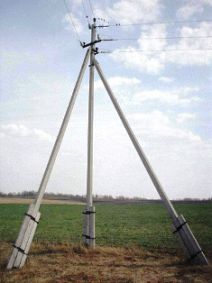
Reinforced concrete support 10 kV
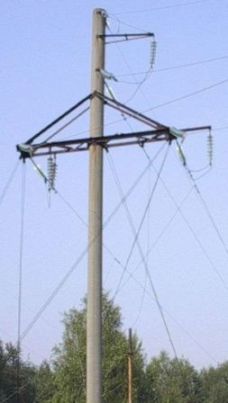
Reinforced concrete support 110 kV
Metal supports of overhead lines
Metal supports (steel) used on power lines with a voltage of 35 kV and above are quite metal intensive and require painting during operation to protect against corrosion.
The service life of metal supports is several times longer than that of wooden ones, but they require significant metal costs and are expensive to operate.
Install metal supports on reinforced concrete foundations. Regardless of the design solution and scheme, metal supports are made in the form of spatial lattice structures.
Metal poles of overhead power lines
Classification of overhead line supports by purpose
By prior arrangement, overhead line supports are divided into intermediate, anchor, corner, end and special.
Intermediate supports are intended only to support wires, do not rely on one-sided heavy. In the case of wire breakage on one side of the support, when attaching it to pin insulators, it slides when knitting and the unilateral tension decreases. With suspended insulators, the string deflects and the voltage also decreases.
Intermediate supports make up the majority (over 80%) of supports used on overhead lines.
On anchor supports, the wires are fixed firmly, so such supports rely on breaking a part of the wires. The wires are attached especially tightly to pin insulators on anchor supports, increasing, if necessary, the number of insulators to two or three.
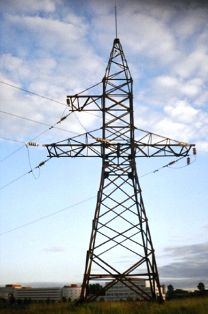
Anchor metal support 110 kV
Often, suspension insulators are mounted on anchor supports instead of pins. Being more durable, anchor supports limit the destruction of overhead lines in the event of an accident.
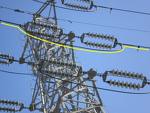 For the reliability of the operation of the lines, anchor supports are installed on straight sections at least every 5 km, and if the ice layer is more than 10 mm thick, at least every 3 km. The front struts are a type of anchor. For them, unilateral pulling of wires is not an emergency condition, but the main mode of operation.
For the reliability of the operation of the lines, anchor supports are installed on straight sections at least every 5 km, and if the ice layer is more than 10 mm thick, at least every 3 km. The front struts are a type of anchor. For them, unilateral pulling of wires is not an emergency condition, but the main mode of operation.
Corner supports installed in places where the direction of the overhead line changes. In normal mode, corner supports perceive unilateral stress along the symmetry of the internal corner of the line. The rotation angle of the line is the angle that completes the interior angle of the line to 180 °.
For small angles of rotation (up to 20 °), corner supports are implemented as intermediate, for large angles of rotation (up to 90 °) — as anchor supports.
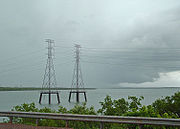 Special supports are built at crossings over rivers, railways, gorges, etc.They are usually much higher than normal and are carried out on special projects.
Special supports are built at crossings over rivers, railways, gorges, etc.They are usually much higher than normal and are carried out on special projects.
Special supports of the following types are used on overhead lines: transpositional — to change the order of the wires on the supports; branching — to perform branches from the main line; transitory — for crossing rivers, gorges, etc.
Transposition is used on lines of voltage 110 kV and above with a length of more than 100 km to make the capacitance and inductance of all three phases of the overhead line circuit the same. In this case, the mutual arrangement of the conductors relative to each other on different sections of the line changes sequentially on the supports. The conductor of each phase passes one third of the length of the line in one place, the second in the other and the third in the third place. Such a triple movement of wires is called a transposition cycle.
Classification of overhead line supports by design
By design, it makes a difference between the supports ° Spruce-rack and consisting of racks and attachments... Wooden supports are performed on wooden or reinforced concrete attachments. When passing overhead lines in places where ground fires are possible, supports with reinforced concrete attachments should be used. For solid supports, which are desirable to use, it is necessary to use long, high-quality antiseptic wood, which limits their spread.
Most intermediate supports perform a single column... Anchor and end supports are A-shaped. For voltages of 110 kV and above, intermediate supports are U-shaped and anchor A-U-shaped.
Abroad, steel cable clamps are used in the manufacture of anchor, end and other complex supports. They have not been distributed in our country.
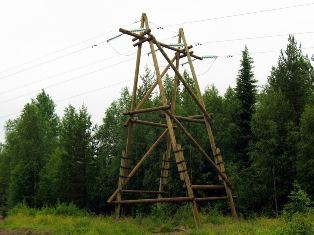
During the construction of overhead line supports, the distances between wires and other objects in the immediate vicinity of the line must be respected.
On lines with a voltage of up to 1 kV in I — III sections of ice, the distance between conductors should be at least 40 cm with a vertical arrangement of conductors and the largest sag of 1.2 m, and in IV and special areas on ice — 60 cm. At other locations of the wires in all areas of ice with a wind speed of up to 18 m / s, the distance between the wires is 40 cm, and at a wind speed of more than 18 m / s — 60 cm.
The vertical distance between the wires of different phases of the support when branching from the overhead line and crossing different lines should be at least 10 cm. The distance between the bushing insulators should be at least 20 cm.
When suspending the conductors of lines with a voltage of up to 1 kV on common supports with conductors of lines with a voltage of up to 10 kV inclusive, the vertical distance between the conductors of higher and lower voltage should be the smallest distance required for lines with -High voltage.
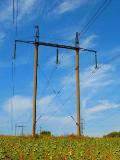 The smallest permissible distance from the conductors of overhead lines to the surface of the earth or water is called line size... The size of the line depends on the areas in which it moves.
The smallest permissible distance from the conductors of overhead lines to the surface of the earth or water is called line size... The size of the line depends on the areas in which it moves.
On intermediate supports for voltages 6 — 20 kV, installed in populated areas, provide double fastening of wires on pin insulators, and suspended insulators are used on anchor and corner supports.
Reinforced concrete supports, as a rule, are made rigid. For a voltage of 0.38 kV, their circuits resemble those of wooden poles.At a voltage of 0.38 kV, they are used to suspend five, eight and nine wires with the same and large cross-section as on wooden supports. props.
For voltages of 35 kV, reinforced concrete supports are made without laying a lightning protection cable and with a cable. The latter are used on the approaches to transformer substations.
